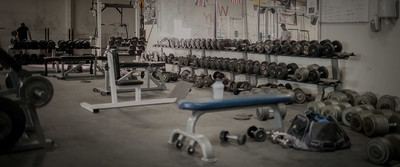Maybe you've thought about lifting weights. Maybe you've even done some dumbbell curls or picked up a barbell. Every time you hit the iron though, you feel unsure, insecure, and a little fearful.
Undoubtedly, you've heard the horror stories: lifting heavy weights makes women bulky, it's dangerous, it's bad for your joints, and once you have muscle, you can't stop lifting or it will all turn to fat. It's all BS, and it feeds into stereotypes that are keeping too many women from experiencing the profound benefits of resistance training.
It's time to put that fear and uncertainty aside. The fact is lifting weights does none of those awful things. What it does is help you to live in a healthier, stronger body.
When you sit down to list your fitness objectives, you may be surprised to learn that that strength training will not only help you reach them, but may reach them faster than performing cardio exercise alone.
Yoga and the treadmill can have their place, but they're not enough. Here are eight reasons you should prioritize strength training in your fitness regimen!
1. More Effective Fat Loss
Think weightlifting only benefits those who want shirt-ripping arms? Think again.
Although many people consider weightlifting only a means to add size, when contrasted head-to-head against cardiovascular exercise, resistance training comes out on top in the battle to burn calories.
The huge advantage to weight training is your body's ability to burn fat during and after exercise.

Think weightlifting only benefits those who want shirt-ripping arms? Think again.
After a heavy bought of strength training, you continue to consume additional oxygen in the hours and even days that follow. This is known as excess post-exercise oxygen consumption, or EPOC.
When your body uses more oxygen, it requires more caloric expenditure and an increased metabolic rate.
2. More Muscle, More Calorie Expenditure
As you increase strength and lean muscle mass, your body uses calories more efficiently. Daily muscle contractions from a simple blink to a heavy squat contribute to how many calories you burn in a given day. Sitting burns fewer calories than standing; standing burns fewer than walking, and walking burns fewer than strength training.
The more muscle contractions you experience during a day, the more calories you'll burn. If you have more lean muscle mass, you'll have more muscle contractions and thus burn more calories.
3. Curves
As you build muscle, your body begins to take a nice hourglass shape. Though endurance exercise can help you lose weight, that weight comes in the form of both fat and muscle tissue.
If you're losing both fat and muscle, you can lose those lovely curves as well. Strength training can help create and sustain them.
4. Quality Sleep
Strength training greatly improves sleep quality, aiding in your ability to fall asleep faster, sleep deeper, and wake less often during the night.
A study published in the International SportMed Journal suggests that morning resistance training or high intensity training greatly affects the quality of sleep and lengthens the time of sleep the night after training.[1]
5. Increased Energy
As noted above, resistance training causes an increase in energy expenditure hours after you train. A study published by the National Institute of Health suggests that the chronic increase in energy expenditure, even after a minimal resistance training session, may favorably effect energy balance and fat oxidation.[2] Rather than reaching for that early afternoon cup of coffee, grab a barbell.
6. Heart Health
Pumping iron can reduce your risk of heart disease and was approved as a healthy form of exercise for those at risk from the American Heart Association. A study in the Journal of Strength and Conditioning found that those who lift weights are less likely have heart disease risk factors such as a large waist circumference, high triglycerides, elevated blood pressure, and elevated glucose levels.[3]
Another study conducted by researchers in Brazil found that though the heart rate increased in patients during heavy bouts of training, their blood pressure and resting heart rate were significantly lower the following morning.[4]
7. Bone Health
As you age, you are at risk of losing both bone and muscle mass. Postmenopausal women are at a greater risk for osteoporosis because the body no longer secretes estrogen. Resistance training is an excellent way to combat loss of bone mass, and it decreases the risk of osteoporosis.

All of us want to feel strong, determined, and confident in everything we do.
A study conducted at McMaster University found that after a year of resistance training, postmenopausal women increased spinal bone mass by 9 percent.[5] The earlier you begin weightlifting, the greater chance you have to maintain bone health later in life.
8. Stress Relief
Exercise in general is a great way to manage stress. Researchers have consistently found that those who regularly strength train tend to manage stress better and experience fewer adverse reactions to stressful situations as those who do not exercise.[6]
In addition, resistance-training studies on older adults show that moderate intensity weightlifting improves memory and cognitive function. Next time you need to blow off some steam, hit the weights.
Ladies, Lift!
All of us want to feel strong, determined, and confident in everything we do: from fitting into jeans, to moving heavy furniture, to playing with kids, to dealing with a stressful career.
Resistance training can benefit in all aspects of your life. Put it in your fitness plan and feel stronger, healthier, and more confident!
References
- Roveda, Eliana, et. Al. Effects of endurance and strength acute exercise on night sleep quality. International SportMed Journal. 2011; 12(3): 113-124.
- Kirk, Erik P., et. Al. Minimal resistance training improves daily energy expenditure and fat oxidation. Med Sci Sports Exerc. 2010; 41(5): 1122-1129.
- Magyari PM, Churilla JR. Association between lifting weights and metabolic syndrome among U.S. Adults: 1999-2004 National Health and Nutrition Examination Survey. J Strength Cond Res. 2012 Nov; 26(11): 3113-7.
- Cardoso, Crivaldo Gomes, et. Al. Acute and chronic effects of aerobic and resistance exercise on ambulatory blood pressure. Clinics (Sao Paulo). 2010; 65(3):317-325.
- Muir JM, Ye C, Bhandari M, Adachi JD, Thabane L. The effect of regular physical activity on bone mineral density in post-menopausal women aged 75 and over: a retrospective analysis from the Canadian multicentre osteoporosis study. BMC Musculoskelet Disord. 2013 Aug 23; 14: 253.
- Stone M, Stone Meg, Sands W. Psychological Aspects of Resistance Training. In: Principles and Practice of Resistance Training. Champaign, IL: Human Kinetics; 2009. p. 229-241.

